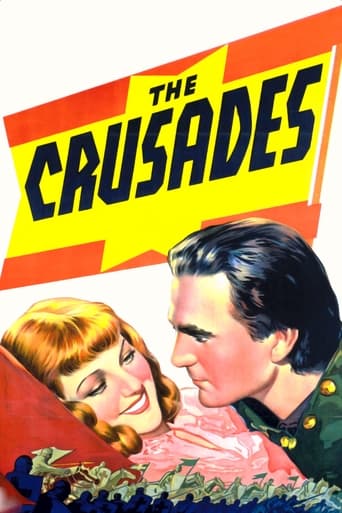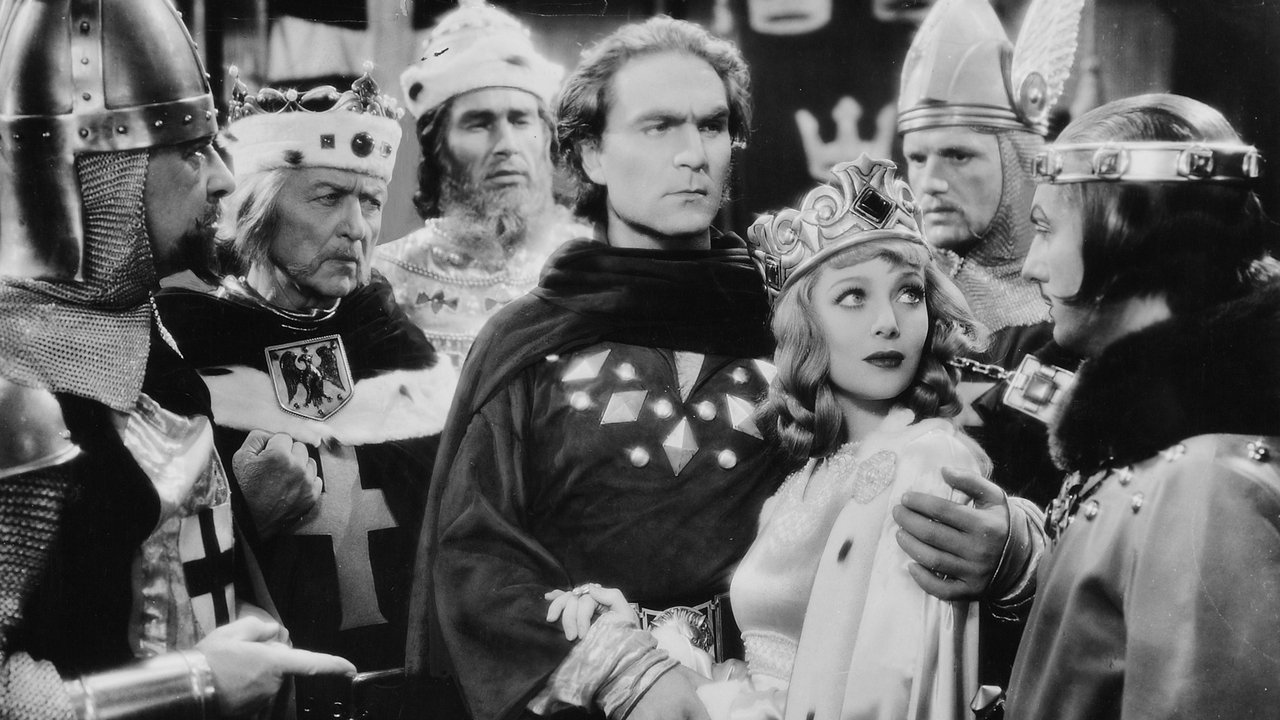bsmith5552
"The Crusades" was Cecil B. DeMille's attempt to depict the crusades of the late 12th century. The first three quarters of the film kind of drag along before the battle scenes emerge in the final quarter.The story opens with a Moses type Hermit (C. Aubrey Smith) vowing that he will raise an army of Christians to re-capture the holy city of Jerusalem from the Sarasins led by Saladin, Sultan of Islam (Ian Keith). King Philip of France (C. Henry Gordon) agrees to join the crusade. Since his daughter Alice (Katherine DeMille) was promised to the English King Richard the Lion Heart (Henry Wilcoxen) by Richard's father, Philip journeys to England to convince Richard to join the crusade and to marry his daughter. Richard relents but discovers an out when he learns that those joining the crusades cannot marry during that time.Along the way with his men in need of food, he meets with King Sancho, King of Navarre (George Barbier) who offers his comely young daughter Berengaria (Loretta Young) in marriage in exchange for the much needed supplies. Richard doesn't take the marriage seriously and sends his minstrel Blondel (Alan Hale) as his proxy. Of course Richard ultimately discovers his new bride and falls in love with her.Then the Christian armies attack the gates of Jerusalem with tragic results. DeMille, as only he could, stages realistic battle scenes for the siege utilizing authentic looking siege towers, catapults and other weaponry. It is the highlight of an otherwise over long film. The film apparently didn't do well at the box office and DeMille did not return to the biblical epics again until 1949 with "Samson and Delilah".Others in Demille's "cast of thousands" are Joseph Schildkraut as Conrad, Marquis of Navarre and Ramsay Hill as Prince John who scheme to take power during their respective leaders absences, Montague Love as the Blacksmith (watch for his touching death scene), and William Farnum, Misha Auer, John Carradine, J. Carroll Naish and Ann Sheridan in smaller roles.Richard needn't have worried about Prince John taking over his throne as Errol Flynn as Robin Hood had every thing under control back home.
Steffi_P
Having witnessed the flop of his last few contemporary dramatic pictures, Cecil B. DeMille made a pledge to the public that from now on he would only make epics. True to his word, he strove to make each successive picture more stupendous than the last. He had made some very effective shoestring epics in the poverty-stricken early 30s, but by 1935 the worst of the depression was over and DeMille could at last be reunited with the big budget.While DeMille had proved on Sign of the Cross (1932) and Cleopatra (1934) that he could make a big picture without masses of extras or impressive sets, he certainly knows how to make the most of those assets when he does have them. It is in The Crusades that we see the development of the style of presentation that he employed for all his subsequent epics. Rather than bombard us with the colossal, he likes to gradually reveal the vastness of a place by slowly and smoothly pulling the camera back. During these moves he usually has an extra or two move horizontally across the frame at a similar pace to the camera, giving the manoeuvre extra grace and momentum. Then there are the battle scenes, tense and frenzied creations of Anne Bauchen's superb editing. These are similar to the ones in Cleopatra, but far more effective, not because of the higher production values, but because the shots are held for longer and their sequencing is better timed.And while DeMille clearly loves the massive crowd shot, he has enough sense to shrink the space and simplify the setting when it comes to key dialogue scenes. Compared to the busy outdoor locations many of the interiors are quite plain, which helps to focus us entirely on the actors, their expressions and their words. The transitions to these dramatic moments are often very smooth, with the drop of a tent flap or simply a change of angle to frame the actors against a bare wall. DeMille was an expert in turning the spectacle on and off, as it were, according to the demands of the narrative.Given the above, it's a pity that, like most DeMille pictures of this era, The Crusades is dramatically rather weak. The dialogue is bland, and most of the characters are lazily-written stereotypes. In the early scenes, there seems to have been this attempt to cram in as many "Olde Englande" accessories as possible, with a cheeky minstrel, a burly blacksmith, the king and his court all hanging out together. Mind you, there is at least a fairly decent character arc in that King Richard is portrayed as a kind of medieval cad who joins the crusade for ulterior motives, but is eventually humbled by his experiences. It's also a refreshingly mature approach to make Saladin an honourable foe, although there is of course still the obligatory moustachioed villain in the form of some anachronistic minor king (played by Joseph Schildkraut, naturally).After having suffered Henry Wilcoxon's wooden turn as Mark Anthony in Cleopatra, it's a major disappointment to see him again in a leading role. You might wonder why DeMille so persistently cast amateurs like Wilcoxon, until you realise he selected players primarily for their physicality, their talent being of secondary concern. In this light it makes sense for Wilcoxon, with his prominent brow and broad shoulders, to play a king. And although Joseph Schildkraut was, as it happens, a very good actor, DeMille repeatedly cast him as these Judas figures because of his thin face and piercing eyes.But this is DeMille. Script and cast will always play second fiddle to the director's showmanship. Despite all the baloney and anachronism, his visual style is on top form here. The Crusades is like a stained-glass window in a church. It will not reach us on an emotional, human level, but it is full of grace and majesty. Yes, DeMille is often called a Victorian moralist, but in his presentation and imagery he was practically medieval. And we should forgive him, because he did it so well.
hundd44
Nobody ever accused DeMille of painstaking historical accuracy - his films are far more the type to set the mood and tell a good story with a historical period as a background. "The Crusades" is a prime example - historically Richard the Lionheart was a lousy king of England who barely spent a year in England during his entire reign - to him, England was merely a source for taxes and troops so he fight the his continental wars. The opening scene of the movie when the Chrisitians captured at Jerusalem are being sold into slavery (with the obligatory Muslim leering at the blonde Christian beauties) is also historically suspect. Saladin and his generals expected the Christian nobility that was captured at Jerusalem to ransom the common people prisoners. When they didn't, Saladin and his generals were so disgusted at such a lack of concern that they ended up ransoming many of the commoners themselves - supposedly Saladin personally ransomed several hundred so they could return to Europe. But I digress.This is a movie which contains a scene that has stayed with me for several decades. I doubt if it would play well today - I can't think of any actors who could pull it off. The scene is where the Christian leaders of the Crusade meet Saladin for the first time when Saladin comes to warn them to go back to Europe. The various Kings, dukes, et al are all seated and listen to Saladin's message. Richard the Lionheart then steps up and tells Saladin that the Christians aren't afraid, that their armies are powerful and to illustrate his point he has two servants hold an iron mace while he proceeds to cleave it in two with his sword. An impressive display of the strength of his blade. But Saladin has a priceless response. He walks over to Berengaria and asks if he can have her silk veil. He takes the veil, tosses it into the air, and then pulls his own sword and positions it below the falling veil, blade up. The veil falls onto the blade and is cut in two by its own weight - for this was a famed Damascus blade. Saladin's point - brute strength isn't everything. Of course, all of the Christian nobles just drop their mouths in utter shock at the demonstration. A priceless scene - and an illustration of the "little things" that separate a humdrum film from one you enjoy watching time and time again.
carvalheiro
"The crusades" (1935) directed by Cecil B.De Mille is as story conceived as love affair, explaining part of the influence that it produced in the internal affairs of two countries as nations in Europe, promoting the allegedly third crusades against Islam, situated at the corner of Southeast on Mediterranean sea. Overall, at the time of vessels charged with horsemen, some of them who went fighting for an apparently common faith but forgotten the symbolic land and cultural influence of diversified local populations, far away of their respectively reigns like France and England. The spirit of cavalry, wedding intrigue, eroticism on the drapes and campaign bed of kingdom of Christianity are ingredients of adventure at the land lost, meaning expansionism and its pretext for quarreling about frontiers and warriors in a love affair at the mood. Director Cecil B.De Mille enjoying us with such subject, altogether he capsizes over our child mind, maybe he was thinking in another configuration for the problem of imperialism and the propriety of rights from these times linking two things, fanaticism and medieval glory at the time of Abyssinia and its nature of rivalries where sex attraction concealed by the strength for power. A tent is the main location concerning an attitude for dealing and in this place both sides made what is better for each one of the intervenor before peoples in conflict in a postponed peace deal. The scene is that tent where both sides entering and a woman is the subject of sharing in between affects that are responsible for the way that the present crusade is understood by the chiefs in place with their costumes and clothes that the director put his energy not to explain why but what burns the heart of kings in that phase of humanity and superiority of Europe before its extremities... This kind of acting at the time was watched as explaining the orders of knighthood in a displaying manner of obvious meaning on public stage at the corner of a town of the ancient world. But historically displaced from the real present time of then in 1935 not at all in relationship of others in incendiary domestic mission where it was inserted such a Hollywood production as a flop.


 AD
AD


